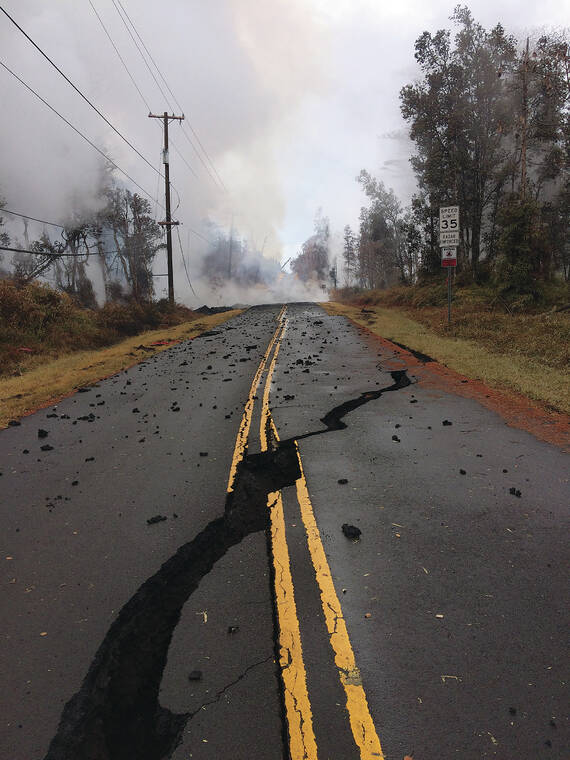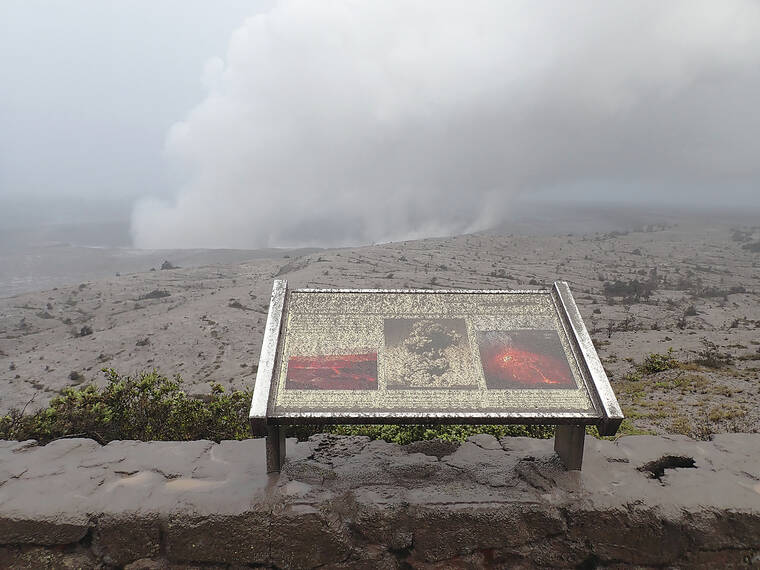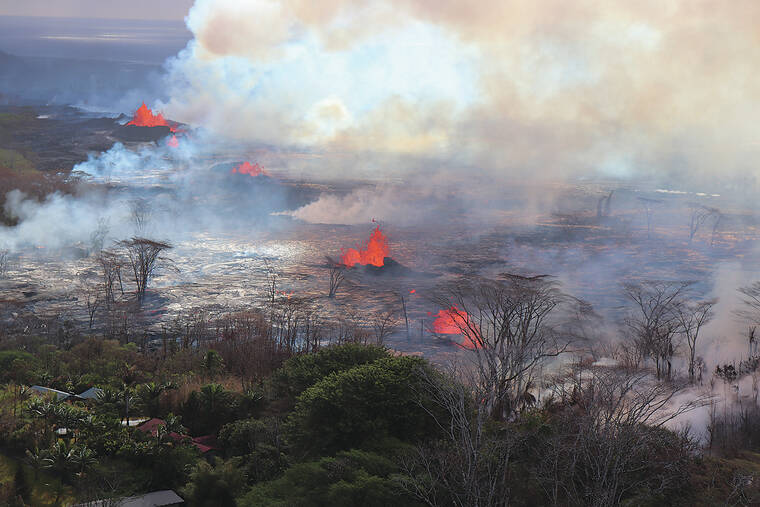Volcano Watch: Five years flow by: Reflections on the destructive 2018 eruption of Kilauea

Large cracks in 2018 run through Leilani Avenue near the old junction with Pohoiki Road. Lava spatter from fissure 6 (out of view on the left) covers the road and volcanic gas rises from cracks in the ground. This area was covered by lava from renewed fissure 6 activity on May 20. (L. DeSmither/USGS)

From the visitor viewing area in front of the Jaggar Muesum at 7:45 a.m. HST. Explosive episodes from the night before in Halemaumau Crater created ash falls which blanketed the surrounding landscape. (Courtesy/photo) (note: no photo credit or source was given online)

An aerial view looking downrift from Leilani Estates in 2018 at erupting fissures 5, 6, 19, and 22. Ponded lava from these fissures fed lava channels moving downslope, right side of the image, including the channels that fed the ocean entries just north of MacKenzie State Park. (S. Isgett/USGS)
Five years ago, volcanic activity at Kilauea dramatically changed when magma intruded into the lower East Rift Zone (LERZ). What happened at Kilauea in 2018? What have been the resulting learning opportunities?
Five years ago, volcanic activity at Kilauea dramatically changed when magma intruded into the lower East Rift Zone (LERZ). What happened at Kilauea in 2018? What have been the resulting learning opportunities?
The events in 2018 ended the 35-year-long Pu‘u‘o‘o eruption (on the middle East Rift Zone), along with the 10-year summit eruption—the summit lava lake drained, as did some of the shallow magma stored beneath the summit, which in turn triggered collapse and subsidence of the summit caldera floor.
The sequence of events began on April 30, 2018, when Pu‘u‘o‘o crater floor collapsed as magma began intruding downrift. Over the next several days seismic and deformation data tracked the dike as it migrated underground farther down the East Rift Zone.
The first LERZ eruption in 58 years began on the evening of May 3 when a fissure opened in the Leilani Estates subdivision. By the end of May 4, six fissures had opened in the LERZ and a magnitude 6.9 earthquake struck the south coast of the Island of Hawaii.
The summit lava lake level began to drop as magma moved into the LERZ, and sections of the unsupported crater walls fell into the lake, triggering small explosive events. Hawaii Volcanoes National Park closed to the public on May 11, and Hawaiian Volcano Observatory (HVO) staff vacated the office on Uekahuna bluff on May 16 due to increased ash explosions, seismic activity, and building damage.
From early May to late August, HVO staff, with help from the USGS Volcano Science Center, the University of Hawaii, and other Department of the Interior offices, maintained a 24-hour field presence and data watch to monitor the eruption and communicate any changes to the public and emergency managers. These collaborations were essential for continuous monitoring and data analysis, but they also introduced new monitoring techniques like using Unoccupied Aircraft Systems (UAS). UAS flights are now included as part of HVO’s routine eruption monitoring tasks.
The 2018 eruption was the most destructive over the last 200 years in Hawaii, with 24 fissures covering an area of over 8,700 acres (35.5 square km) including the addition of 875 acres of new land beyond the old coastline. Over 700 structures and 30 miles (48 km) of roads were covered, displacing many residents. Gas emissions were at the highest levels ever recorded at Kilauea and impacted much of the state of Hawaii and areas as far away as Guam.
The summit region experienced 62 total collapse events during the eruption. These near-daily occurrences each released energy roughly equivalent to a magnitude 5.3 earthquake. Shaking from these events caused damage to nearby homes and businesses, along with Hawaii Volcanoes National Park roads and infrastructure and the former HVO building. Volcanic ashfall from explosions in May and gas emissions also impacted downwind communities in the District of Ka‘u.
Recovery efforts are still underway for Island of Hawaii communities impacted by the 2018 eruption, and for HVO.
The Additional Supplemental Appropriations for Disaster Relief Act of 2019 (H.R. 2157) has provided new opportunities for HVO to bolster monitoring and eruption response abilities and is supporting research that will help us to better understand Hawaiian volcanoes.
Some of HVO’s new monitoring capabilities include cutting-edge field equipment for tracking seismicity, ground deformation, gas, gravity, lava lake level, and surface changes. Lab equipment that can analyze physical and chemical characteristics of ash and cinder and lava samples, providing insights on eruptive processes, has also been acquired thanks to the supplemental funding.
Exciting new research has also been taking place at Kilauea to help improve our understanding of the volcano’s magma plumbing system and structure, eruptive past, and hazards. This includes the ongoing Kilauea Seismic Imaging Project.
In the years since 2018, HVO has had the opportunity to apply lessons learned during 2018 to several Kilauea summit eruptions and the first Mauna Loa eruption in 38 years. Research and monitoring upgrades funded through the supplemental funding have advanced our understanding of Hawaiian volcanoes, helping us to learn more about their hazards and potential future eruption impacts.
Volcano Activity Updates
Kilauea is not erupting. Its USGS Volcano Alert level is ADVISORY.
Webcams show no signs of active lava in Halema’uma’u crater, at the summit of Kilauea in Hawaii Volcanoes National Park. Over the past week, summit tiltmeters showed inflation and seismicity has been variable. The summit sulfur dioxide (SO2) emission rate was most recently measured on May 3, when it totaled 135 tonnes per day.
Mauna Loa is not erupting. Its USGS Volcano Alert Level is at NORMAL.
Webcams show no signs of activity on Mauna Loa. Seismicity remains low. Summit ground deformation rates show inflation above background levels, but this is not uncommon following eruptions. SO2 emission rates are at background levels.
There were two earthquakes with 3 or more felt reports in the Hawaiian Islands during the past week: a M3.0 earthquake 4 km (2 mi) SSE of Pahala at 31 km (19 mi) depth on April 29 at 6:34 p.m. HST, and a M0.5 earthquake 4 km (2 mi) SW of Volcano at 1 km (0 mi) depth on April 27 at 7:59 a.m. HST.
HVO continues to closely monitor Kilauea and Mauna Loa.
Please visit HVO’s website for past Volcano Watch articles, Kilauea and Mauna Loa updates, volcano photos, maps, recent earthquake information, and more. Email questions to askHVO@usgs.gov.
Volcano Watch is a weekly article and activity update written by U.S. Geological Survey Hawaiian Volcano Observatory scientists and affiliates.


